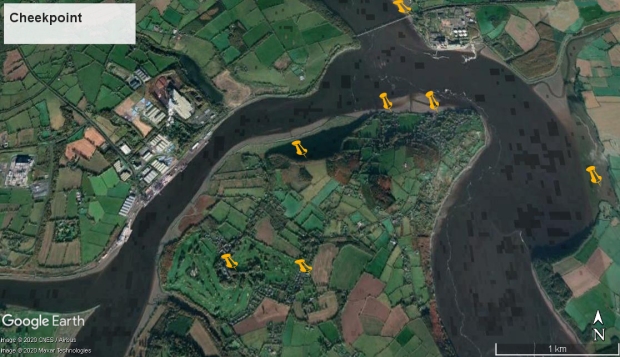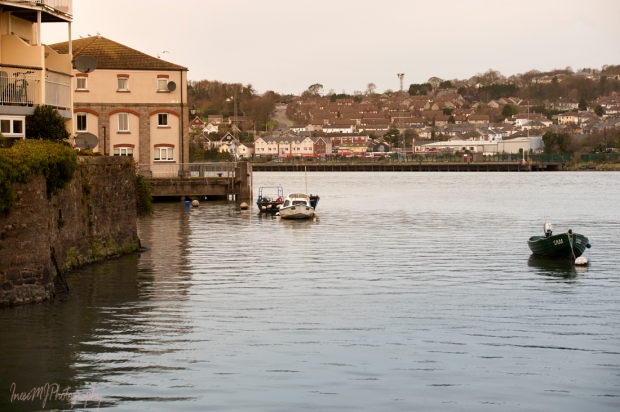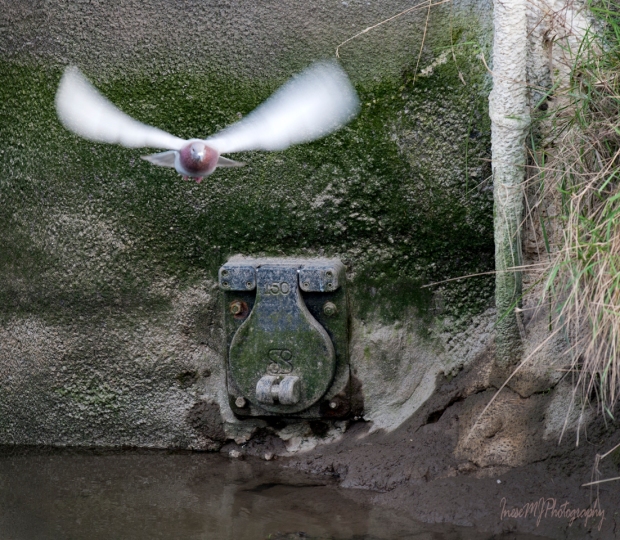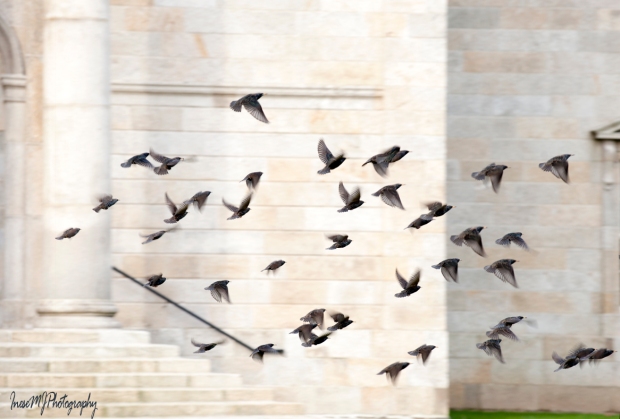
I have written about River Suir before. Two latest Little Island posts gave me idea of following the river a little further. On the map below you see the Little Island pointing to the green chunk of land with the river coiled around it. It is the point where the rivers Barrow and Nore meet their sister Suir and together start their final journey to the sea.
I don’t even have to write much – Cheekpoint has a resident blogger and author Andrew Doherty
You see a couple of pins on the map. They mark the places where my pictures were taken from. I will add some commentary, but most of the information I am going to share with you has come from Andrew’s blog Waterford Harbour Tides and Tales.

To get to Cheekpoint, we make a right turn from the Passage East Road, Waterford, and keep to the left under the bridge. The first thing you notice is a ruin surrounded by trees and ivy that is not marked on my map. The ruin is not a tower or castle but a mill that ceased to operate in the 1930-s. Delahunty’s Mill is a silent relic of the industrial past of the land.

After Strongbow arrived in Waterford harbour in 1170, Henry II landed in Passage East the following year and granted strategically important lands surrounding the harbour to Juvenis Aylward, a merchant from Bristol who provided financial support to the expedition. The lands remained in the Aylward family for 450 years and went to the Cromwellian ‘officer of Dragoons’ Captain William Bolton in 1667. His descendants had been farmers, politicians and businessmen who built Faithlegg House, established Cheekpoint village, port, cotton manufactory and hofiery ( read about the Stocking Frame here), lime kilns and mills. They planted a forest, drained and walled salt marshes, improved the roads; Cheekpoint Packet Station run by Captain Thomas Owen commenced in 1787 and flourished until the end of Napoleonic Wars.
When we emerge from under the bridge, there is an old building on our left, Jack Meade’s bar. Their beer garden looks very attractive, and they also have two 19th century lime kilns and an ice house in the grounds. The bar dates back to 1705 and belongs to the present family since 1857.

We follow the Cheekpoint road and turn left after a couple of miles to Faithlegg Golf Club .
Cornelius Bolton inherited the Faithlegg estate in 1779. Being a prominent Waterford businessman and politician he built a stately house ( the architect is believed to be John Roberts). Unfortunately, with the end of Napoleonic Wars most of his investments failed and he had to sell the house to Nicholas Power and retire to his Waterford residence. Nicholas adorned the House with his family crest – the Stag head. In 1935 the House was sold and became a De La Salle college; in 1998 – a golf club and hotel.


We return to the main road and stop at the Faithlegg Church and graveyard. There is a ruin of a nave and chancel of the church that was possibly built in the 13th-14th century, however there are written records of this church in the 12th century. The difference in masonry of the front and back part of the ruin indicates that there are indeed two churches – one built in Romanesque style, and the other in a later Venetian Gothic style. The ruin is preserved by the efforts and financial help of community.

There is also a newer church that dates from 1826 and is still in use. This is a 1928 image of it from https://tidesandtales.ie/old-faithlegg-churc/. The spire was erected by Nicholas Power. The church looks pretty much the same except for the shrubbery and ivy which are gone now.

In the church graveyard there is a number of remarkable graves, like the grave of William Doyle who sailed the globe with Captain Cook. There is also Thomas Francis Meagher family vault.
We continue along the Cheekpoint road and turn left, up the Minaun Hill. A short walk from the car park takes us to the top. The views are spectacular. Dunbrody Abbey in the picture below is just a couple of miles away, but they say you can see seven counties from here on a clear day.

Numerous steep trails take you around the hill so that you have a 360° view. This is Port of Waterford.

This is the Faithlegg House with Little Island in background. You can see the black&white tower if you zoom closer.

A massive piece of volcanic rock – The Cromwell’s Table – is a popular viewpoint. If you are tall enough you might see Saltee Islands from here. In the picture below you see the estuary and the village of Passage East. We will get there in the end of this blog.

The Rhododendron Walk is another beautiful and mysterious place. It stretches on the north part of the Minaun, closer to the Waterford port on the other side of the river. I had a blood-chilling experience while walking there alone in twilight last year. I even have a horror video from that walk, but cannot figure out how to post it in WordPress. So I will keep this story for the future use.


After all the walks and sight-seeings we finally reach the Cheekpoint village. This elegant red brick building, now a family home, used to be another Cornelius Bolton’s enterprise – a Coaching Inn. Daisybank House has a long history of which you can read about in Andrew’s blog.

Here are some pictures of Cheekpoint port and strand taken in different years.


The following eight pictures are taken from the strand.

Fog is a frequent occurrence in Cheekpoint.

Cheekpoint fishing weirs have a long history. Here you can learn the difference between Head weirs and Scotch weirs, and read about the Weir Wars.

Barrow railway bridge was opened in 1906 and closed in 2010. Nearly mile long, it has 13 spans one of which opens to let the yachts pass under the bridge. Sad that this beauty has no practical use anymore, but being an important landmark it is very appreciated among photographers.



A flock of Godwits are picking lugworms at low tide.

With SMARTPLY manufacturing site in background, we walk to the end of the strand towards the Rookery.

All the buildings in the Rookery are unique. The time has stopped there long ago.

This house was built by Cornelius Bolton junior in 1786-1800. The house comes with the quay, dock and walled garden. I have read that the fishing weirs used by the owner’s family were built by Cistercian monks in 1177.

The house was for sale at the time of my visit, so I went to the quay and took this picture.

This is the dock and remains of the ancient fishing weirs. I fell in love with the place. I think it has been sold by now 🙂

Here are some closer pictures of the Barrow Bridge.


This is what Cheekpoint and Minaun Hill look like from the opposite bank.

In the picture below you see the Russian Side – the east part of Cheekpoint. The twin stacks on the right belong to the Great Island power station sitting across the river like a sore thumb. In my previous pictures I made sure to keep it out of frame. The picture was taken from the Wexford side of the river. I don’t know the story of the abandoned boat. You can see it in Google Earth.

Besides photography, there is another cool thing you can do in Cheekpoint: ship watching.

Up to twenty ocean liners used to visit Waterford annually. Only the larger ones drop anchor at Dunmore East – the other ships continue to the Port of Waterford at Belview, passing Cheekpoint on the way.
On my last visit in September I was lucky to observe Pacific Princess departing from Port of Waterford. I was on my way home when I caught a glimpse of the liner through the gap between the trees. I took a few pictures and hurried to Passage East.

For those who remember the name – it is not THAT Pacific Princess. The ship featured in the romantic comedy series The Love Boat was purchased by Turkish shipbreaking company Cemsan in 2012 and obviously ceased to exist. This Princess was built in 2002.
Princess Cruises have a history of ‘deliberated pollution’ – illegal waste discharge, but it seems that Pacific Princess has no major problems with environmental compliance.

I arrived to Passage East just in time to hear the ship horn blast as she passed the village and continued through the estuary to the Irish Sea. The passage from Belview to the sea is approximately 1.5 hours.

Thank you for joining me on this walk around Cheekpoint and Faithlegg. We will return to River Suir to walk the 20 km long Blue Way, this time in County Tipperary.
 Have a happy week!
Have a happy week!
 Have a happy week!
Have a happy week!









































































































 Have a wonderful weekend!
Have a wonderful weekend!



























